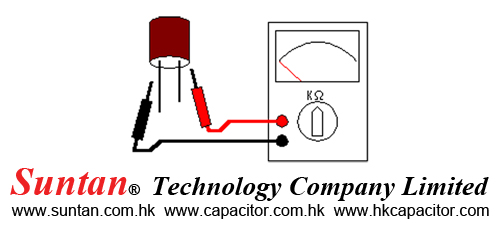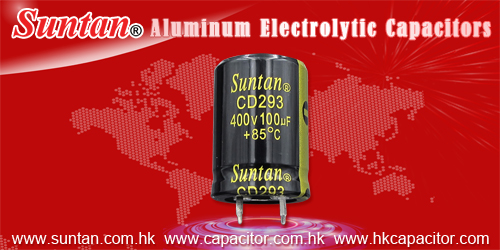Suntan Technology Company Limited
---All kinds of Capacitors
- The capacitor's function is to store electricity, or electrical energy.
- The capacitor also functions as a filter, passing alternating current (AC), and blocking direct current (DC).
- This symbol is used to indicate a capacitor in a circuit diagram.
The capacitor is constructed with two electrode plates facing eachother, but separated by an insulator.
When DC voltage is applied to the capacitor, an electric charge is stored on each electrode. While the capacitor is charging up, current flows. The current will stop flowing when the capacitor has fully charged.
When a circuit tester, such as an analog meter set to measure resistance, is connected to a 10 microfarad (µF) electrolytic capacitor, a current will flow, but only for a moment. You can confirm that the meter's needle moves off of zero, but returns to zero right away.
When you connect the meter's probes to the capacitor in reverse, you will note that current once again flows for a moment. Once again, when the capacitor has fully charged, the current stops flowing. So the capacitor can be used as a filter that blocks DC current. (A "DC cut" filter.)
However, in the case of alternating current, the current will be allowed to pass. Alternating current is similar to repeatedly switching the test meter's probes back and forth on the capacitor. Current flows every time the probes are switched.
The value of a capacitor (the capacitance), is designated in units called the Farad ( F ).
The capacitance of a capacitor is generally very small, so units such as the microfarad ( 10-6F ), nanofarad ( 10-9F ), and picofarad (10-12F ) are used.
Recently, an new capacitor with very high capacitance has been developed. The Electric Double Layer capacitor has capacitance designated in Farad units. These are known as "Super Capacitors."
Sometimes, a three-digit code is used to indicate the value of a capacitor. There are two ways in which the capacitance can be written. One uses letters and numbers, the other uses only numbers. In either case, there are only three characters used. [10n] and [103] denote the same value of capacitance. The method used differs depending on the capacitor supplier. In the case that the value is displayed with the three-digit code, the 1st and 2nd digits from the left show the 1st figure and the 2nd figure, and the 3rd digit is a multiplier which determines how many zeros are to be added to the capacitance. Picofarad ( pF ) units are written this way.
For example, when the code is [103], it indicates 10 x 103, or 10,000pF = 10 nanofarad( nF ) = 0.01 microfarad( µF ).
If the code happened to be [224], it would be 22 x 104 = or 220,000pF = 220nF = 0.22µF.
Values under 100pF are displayed with 2 digits only. For example, 47 would be 47pF.
The capacitor has an insulator( the dielectric ) between 2 sheets of electrodes. Different kinds of capacitors use different materials for the dielectric.



